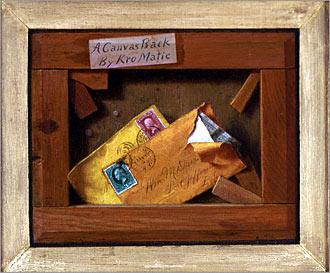Notes from Frankenstein, Alfred. The Reality of Appearance: The Trompe L’oeil Tradition in American Painting. Netherlands: New York Graphic Society Ltd., 1970.
Catalog for “the first major museum exhibition of American trompe l’oeil.” Organized by the University Art Museum at Berkeley, it traveled to the National Gallery of Art in DC, the Whitney in NYC, the University Art Museum in Berkeley, the California Palace of the Legion of Honor in SF, and the Detroit Institute of Arts all in 1970.
The catalog includes two examples of the back of the canvas theme.
John Frederick Peto’s Lincoln and the Pfleger Stretcher from 1898 (p. 100) and William M. Davis’s A Canvas Back possibly from circa 1870 (p. 54).
It’s not certain who used the idea first or if they came up with it independently.
The Pfleger Patent was a type of stretcher that Peto often used and because it had a distinctive form – beveled and beaded – it was used to differentiate between Peto and William Harnett’s work. The Lincoln portrait was also a common way to distinguish Peto’s work. The Lincoln portrait was based on an engraving based on a photograph by Matthew Brady. (similar to the Galatea engraving) The Lincoln portrait is unfinished around the mouth, according to Frankenstein this was common of Peto in his later years.
The second example is William M. Davis’s “A Canvas Back”. This painting features a note identifying the artist and letters hidden in the back of a canvas.

